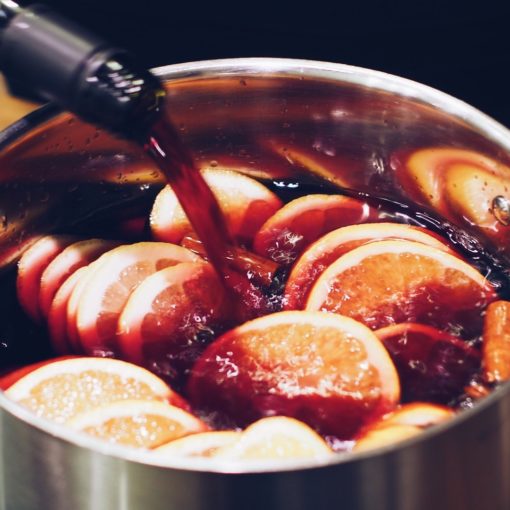[This post may contain affiliate links where we earn a small commission. Please see our disclosure for more information and thank you for supporting our site so we can continue to bring you awesome content for your travel inspiration!]
This Post Has Been Updated for 2023 Karneval Dates and Information
On November 11th at 11:11am, Karneval season officially begins. Although, you may not really even know it, since the best Christmas Markets in Germany always hold the shining light in November and December (and don’t forget about the devilishly fun Krampus Parades as well!) but once the Christmas lights fade away, in some places throughout the country, people begin prepping to Celebrate Karneval and Fasching in Germany.
In this guide, you’ll learn what is Karneval vs Fasching in Germany, where the best places to celebrate it are, and HOW to properly get your mischievous side in full force for the festivities!
2023 Karneval and Fasching Dates: Feb. 16 – February 21 (Ash Wednesday falls on Feb 22)
You'll Find In This Article:
The German Mardis Gras: Karneval in Germany (Fasching)
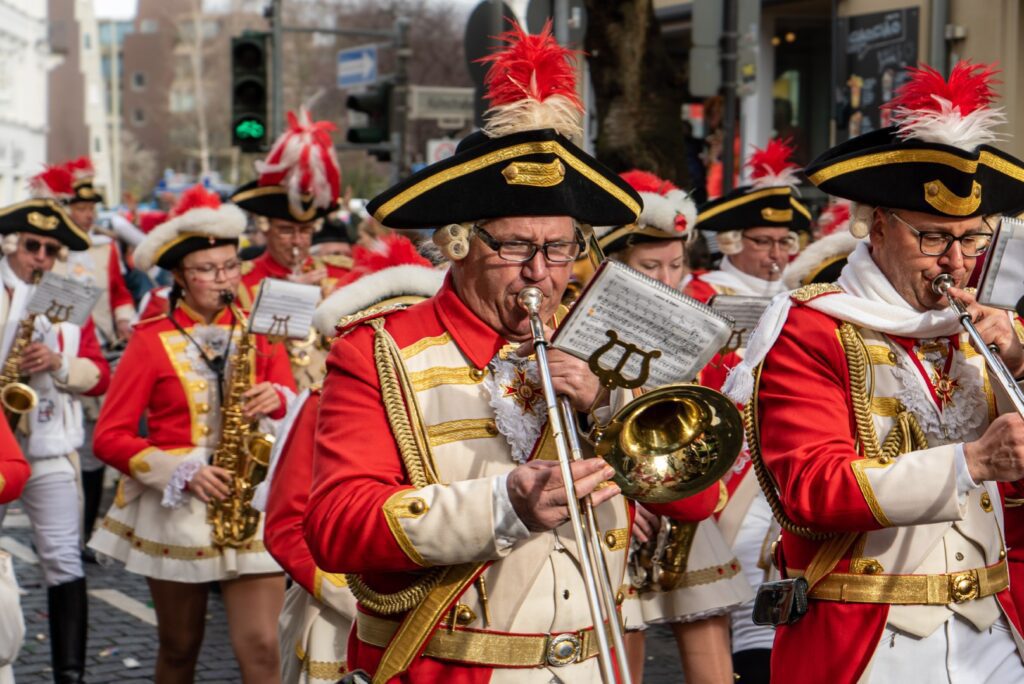
Ok, so let’s start with what is German Karneval? And is Karneval the same as Fasching? And most importantly, will there be German beer at these festivals!?!?
Most people know what Mardis Gras is, so the explanation of Karneval (Carnival) in Germany is pretty much the same, for the sake of brevity. There is a big culmination of events that happen on Fat Tuesday, or in Germany, it’s often called Fasching Dienstag or Shrove Tuesday, which is the day before Lent begins in the Catholic church.
How It Started
Since Lent is a time in the Catholic church where people use the six weeks to repent for their sins, give up bad habits, and sacrifice vices, the days leading up to it is a great excuse to get all those gluttonous and mischievous behaviors out one, last time. Then, they can focus on penance and self-discipline during Lent. Well, at least this USED to be one of the reasons for crazy shenanigans during Karneval!
And since people may be doing some “questionable” behaviors (especially in the eyes of the Catholic church) in as early as the 1200s, the commoners would often wear masks and disguises so that their true identities were not revealed.
But today, you don’t need to be Catholic, or even giving anything up during Lent to let loose during Karneval in Germany.
In other regions in Germany, it goes back even further in time to pagan practices where they would hold “parades” where they scared away any winter demons (hence certain costumes in certain regions).
What is Fasching?
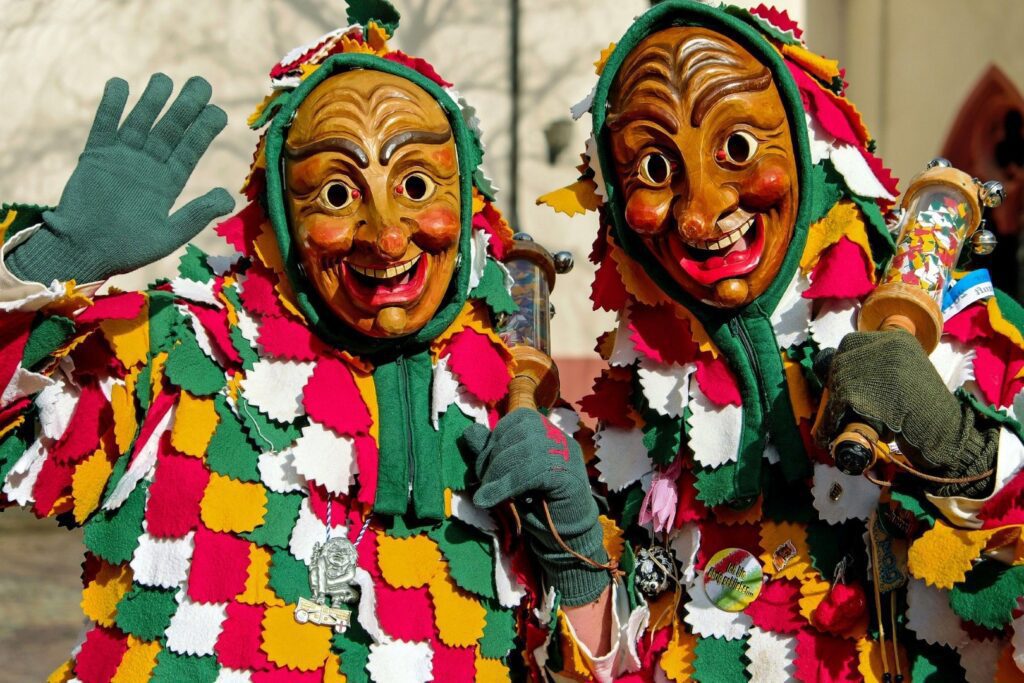
Ok, so we know what German Carnival is, but then what the heck is Fasching? And is Fasching in Germany different from Fastnacht!?
Well, to put it simply, it’s all really the same thing, more or less. It may be called different things in various regions and there are often slightly different cultures and customs that happen depending on where in Germany you are, but at the end of the day, it’s all just a giant party today!
For example, in Bavaria, Saxony, and even in Berlin, it’s more often called Fasching (in Franconia, you’ll hear Fastnacht more) and in the Rhineland region, it’s Karneval. But that isn’t a hard and fast rule, but as long as you’ve got your costumes out and are ready to drink some beer, dance, and have fun, then you’ll be good!
Other Names for German Karneval:
- Fasching
- Schoduvel
- Fastnacht (more common in Swabia)
- Fasnet
- Fassenacht
- Mardi Gras: Particularly the closer you get to France, you may hear this term
And while they all may have slightly different origins, today, they are all, basically, a similar festive time full of parades, dancing, music, free-flowing booze, costumes, and good fun!
Alemannic Fastnacht
And then there’s Fastnacht. This is a special kind of Carnival in Germany celebration and is typically more in the Swabia region. While there is still plenty of celebration and fun, the highlight is that this is more on tradition.
Instead of store bought and silly outfits, the attire is elaborate and detailed costumes and many hand carved wooden masks. These are often so cherished that they are passed down from generation to generation. Witches, devils, and other “Wilde Leute” are seen parading down the streets scaring away any evil winter spirits to bring in the spring time!
What Can you Expect at Fasching in Germany
It’s Everywhere
Heading to the grocery store? Sight seeing an Altstadt? Everywhere you go during Karneval (especially in cities like Cologne that celebrate it hard) you can expect anyone and everyone to be dressed up and having a good time!
The stereotype of serious and stone faced Germans is replaced with friendly partiers, jesters, and clowns everywhere!
And while Karneval used to be celebrated more in the Catholic regions, Fasching and other festivities are pretty much found all over Germany today (Germans never pass up an excuse to go have a party!)
Most cities and towns will have their own parades as well, big or small!
Costumes Are A Must!
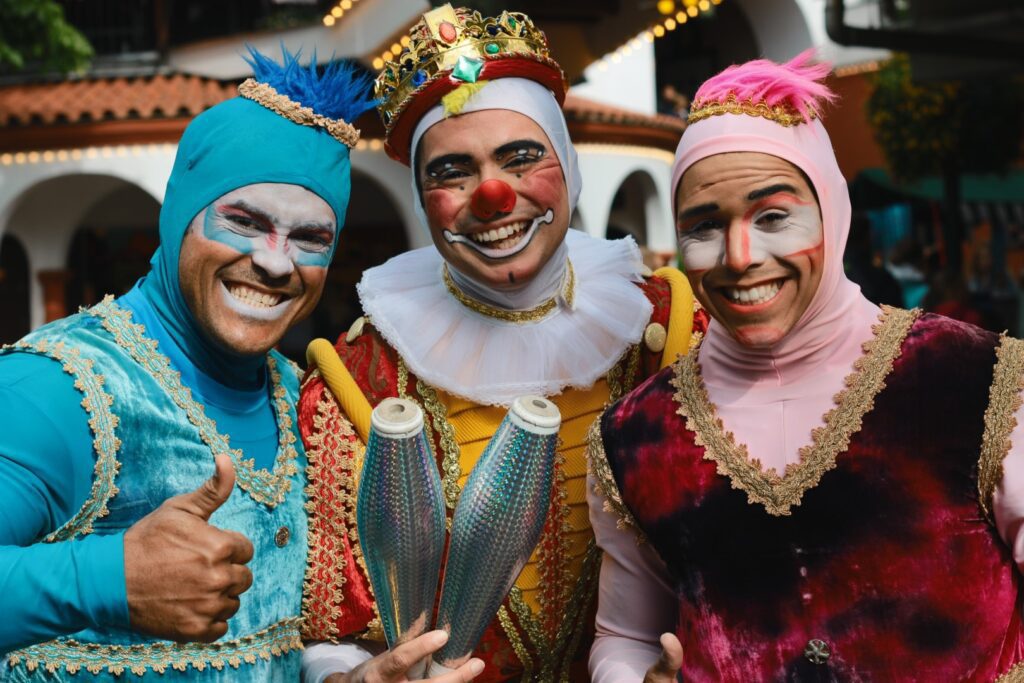
Since they don’t do Halloween the same way we do in the US, this is sometimes known as “Germany’s Halloween.” Everyone from young to old dresses up in costumes!!!
Originally, when Karneval was a way to make fun of local leaders and politicians as well as take jabs at current events, costumes of jesters, clowns, and royalty figures were more common, which is why you’ll still see these as popular costume choices. Since there are even some pagan influences in Fasching, witches are also a typical outfit you’ll see.
But today, pretty much any costume goes! In particular, people really enjoy forming groups (often from a club or an organization or just simply as a family or group of friends) where they create a themed costume. This can be anything from all the characters of Mario to a box of crayons to a group of pigs!
Parades
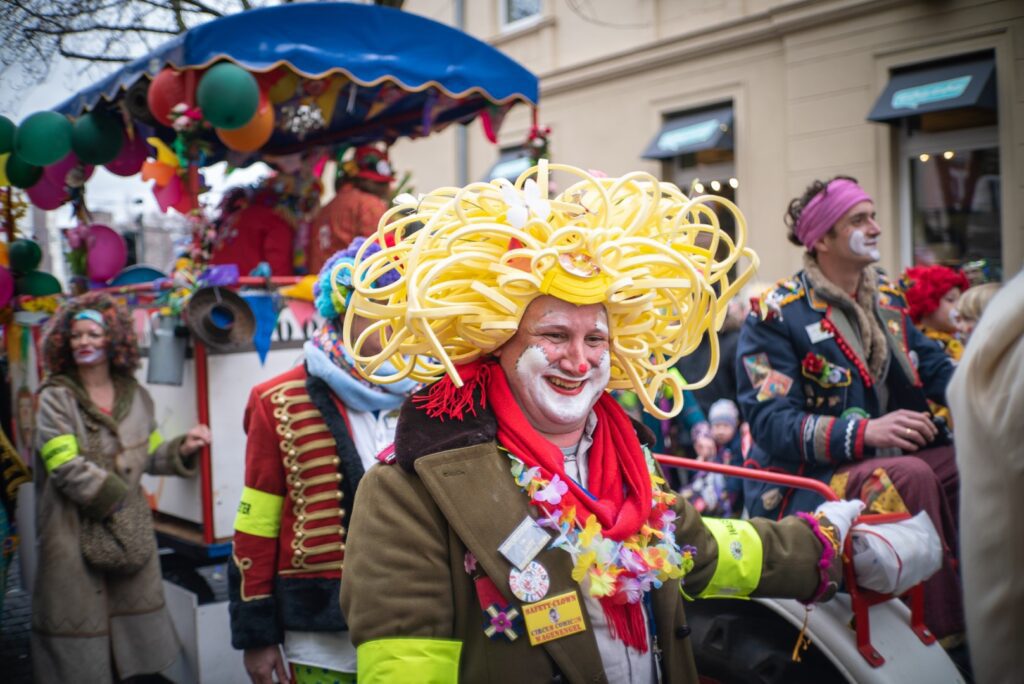
What is Fasching or Karneval without a Carnival parade in Germany!?
There are small parades of people processing down the main streets of town. There are HUGE parades that last for HOURS that have hundreds of thousands of people participating. There are parades with gorgeous and elaborate floats and there are parades that are basically a giant street dance! Parades are EVERYWHERE during Karneval and Fasching in Germany!
Local organizations, groups of friends, and dance troops all can join in most parades and it can be quite the spectacle to watch.
And like any good parade, plenty of candy will be thrown out to all the spectators on the sideline!!!
Kissing
Well, maybe this is more of a pre-covid thing, but there is the odd tradition of kissing random strangers during Karneval! Whether it be to get some candy or in exchange for cutting a guy’s tie off (more on that below) there is plenty of lip locking going around!!!
So, don’t be surprised if you turn around and get caught off guard with a big ol’ smooch from a total stranger!
Dancing
The town in Footloose would absolutely lose it if it saw what happens during Fasching and Karneval in Germany! At any given moment, a dance party could erupt on any street corner or town square!
Singing
Every region seems to have its own set of party songs for Karneval. In Cologne, almost all the Karneval songs are in the local Kölsch dialect and if you really want to blend in with the locals, you’ll want to brush up on them to fit in!
Tie Cutting and Girl Power
This is a funny little tradition that started back in the 1800s that still remains to this day with plenty of jest. It all started when a group of women had had it with gender inequality in general, but especially at the time of Karneval, when the men could go out and party but the women had to stay behind like little good housewives and tend to the house and kids.
So one day, a group of women got together and said, “Aaaaw Hell NO!”
They stormed to the city, found the men, cut off their ties, and claimed the day as their own!!!! (I’d like to think that maybe one of my own ancestors was in this badass group of feminist women!) And thus, “Weiberfastnacht” began!
To this day, on Karneval Thursday, if you find yourself wearing a tie, watch out! You’ll get it chopped off, but don’t worry, you might just get a kiss in return for your troubles!
Alternatively, since the Catholic church eventually kind of “took over” Karnveal from pagan influences, there used to be a strong religious tie (no pun intended) to the events. Therefore, in the days leading up to the intense fasting time of Lent, even nuns were allowed to go wild. They could gamble, dance, and eat whatever they wanted!
Straw Men Being Burned
Particularly at Karneval in Köln, you’ll see a straw stuffed dummy hanging around town; he’s the “Nubbel”. At the end of Shrove Tuesday, this “Nubbel” is thrown into huge bon fires, where he’ll atone for all your heathonous sins from the last week!
Planning Your Timeline of Karneval
If you are planning on attending Karneval in Germany events, it’s important to plan ahead, book accommodations early in the larger party cities, and have a game plan for partying, recouping, and partying again!
First, you need to figure out when Ash Wednesday is (the first day of Lent). This year, in 2023 it is Februrary 22nd. The festivities will begin the Thursday prior to this. Here’s what to expect on each day so that you can plan your time.
Wieberfastnacht (Thursday)– Women’s Day! Huzzah! The parties begin, women are found chasing men with scissors, and a good ol’ time is had by all!
Friday– Get back to work, folks! Not a WHOLE lot will happen on Friday during the day, but there could still be some activities, especially in the evenings.
Saturday and Sunday– Expect some parades to start happening in towns throughout Germany. This is often when some of the elegant and fancy balls and masquerades occur as well.
Rosenmontag (Rose Monday)– In the bigger cities that really go nuts for Karneval, like Cologne, Rose Montag is the day for the HUGE parades!
Faschingsdienstag (Shrove Tuesday)– Party it up, fools! Bonfires are ablaze and masquerade where they finally reveal their true identities at midnight occur. This is THE day to party if you are in town! Late into the night, in some regions, the Nubbel man will be thrown into the fires so that a cleansing, new season may start in the morning.
Ash Wednesday– Repent for your sins all you heathens! The Karneval festivities are over and Lent has begun. In the very religious state of Bavaria, it is designated as a “quiet day” and plenty of people go to church to start their Lent off with repentance.
Where to Celebrate Karneval In Germany
Karneval in Cologne
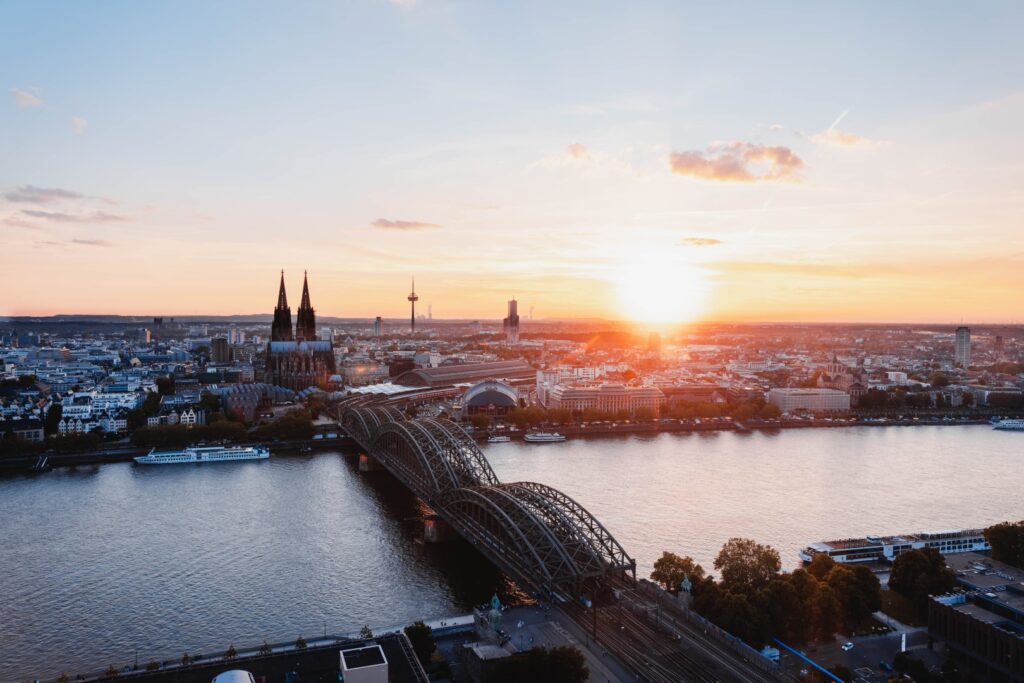
The Cologne, Germany Carnival is arguably one of the biggest celebrations in all of Germany, maybe even in all of Europe! In fact, over 1.5 million people flock to the Köln Karneval each year to party it up!
The “Köln Karnevalszug” (Parade) on Rose Monday is one of the most impressive in Europe, which stretches a whopping 7km that winds through the city. But don’t be surprised to find processions at any other given moment, huge dance parties randomly breaking out here and there, horses, and millions of people ready for a great time!
One thing that makes the Cologne Karneval interesting is the integration of the regional, local, Kölsche dialect. It is heard in the songs and in phrases all over town.
Carnival in Düsseldorf
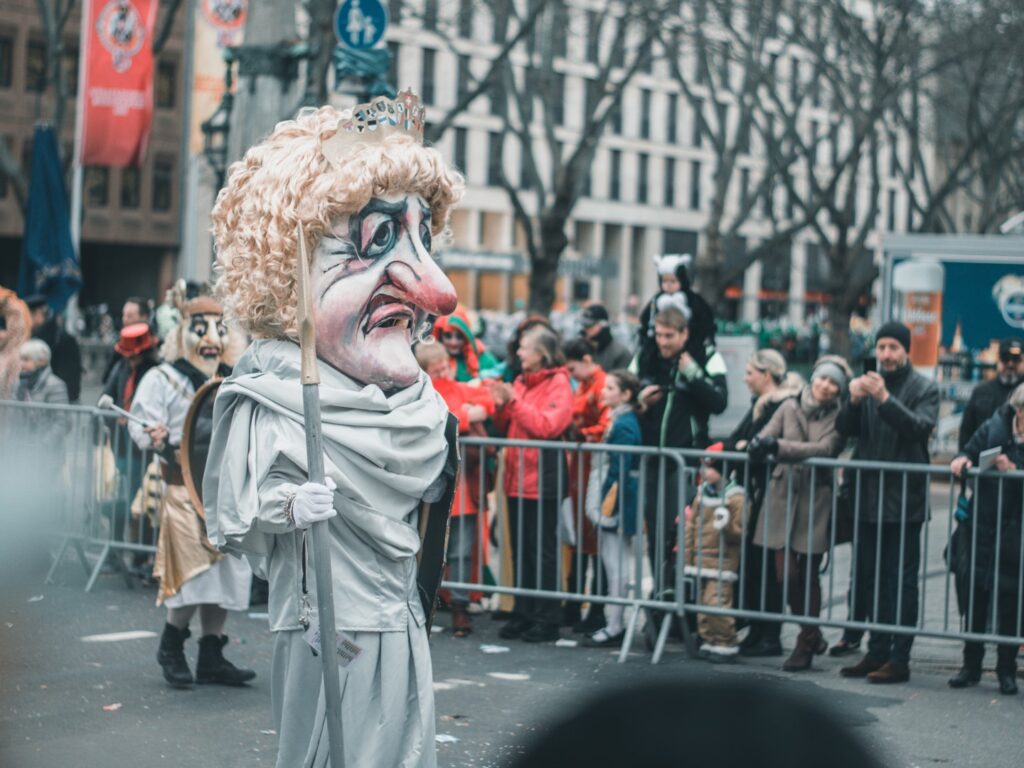
Another fantastic place to celebrate Karneval is in Düsseldorf! While the parade may not be AS big as Cologne’s, Düsseldorf’s 5km long parade is still nothing to scoff at! The people in the Düsseldorf Karneval Parade is also a blast, as the costumes are usually fantastic and plenty of bands and other organizations attend to keep the parade a rocking good time!
And even though the parade on Rose Monday is probably the biggest event, there will also be other unofficial parades and plenty of parties throughout the city on the other days of Karneval as well to make it a great place for the festivities.
Fasching München
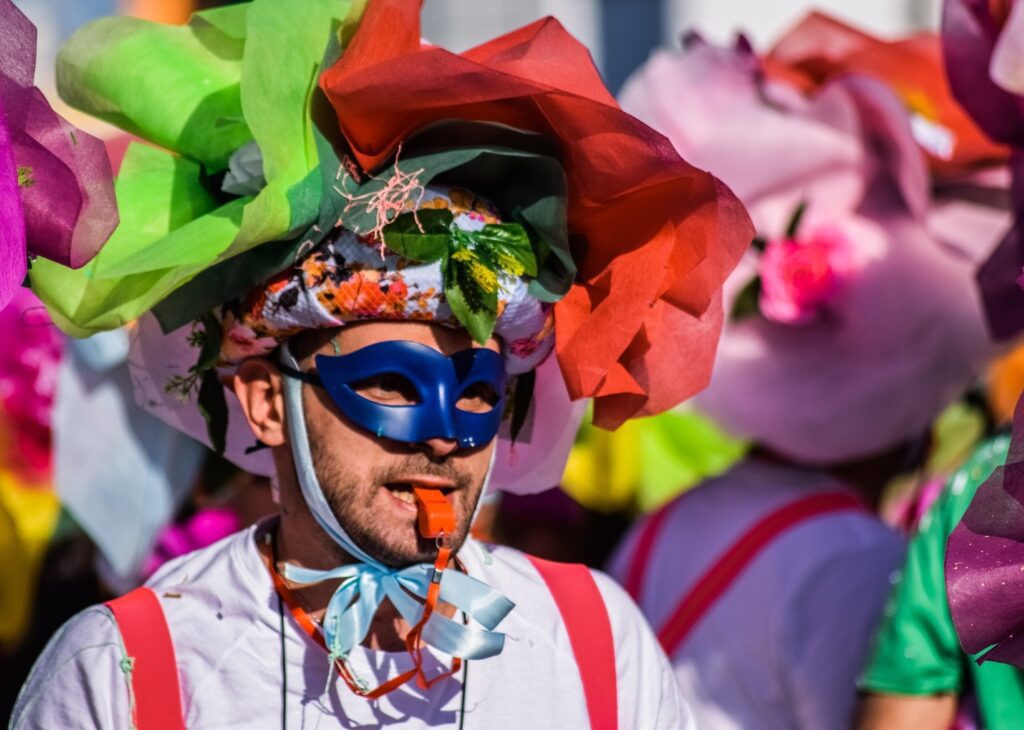
Move over Oktoberfest, Germany celebrations in Munich aren’t just about the classic beer fest in the fall. Bavaria is always a place tourists love to visit, and Fasching in Munich is surely a time that will be remembered!
While of course, there will be Fasching parades, Munich also has tons of masquerade balls as well as concerts throughout the Fasching time.
One unique thing that Munich Fasching does is the “Tanz der Marktweiber auf dem Viktualienmarkt” or the “Dance of the Market Women” at the Viktualienmarkt on Shrove Tuesday. It all started long ago when the women who ran the stalls at the Viktualienmarkt decided to dress up and dance outside their stalls. Today, elaborate dances are now a big part of the excitement of this day!
Another thing that you MUST do while celebrating Fasching in Germany is to get in on the “Fasching Donuts” craze! In Bavaria, we call them “Krapfen” though and they are a delicious pastry fried, filled with jam, and sprinkled with powdered sugar. However, especially on Fat Tuesday, this is such a big deal that if you want to get yourself some Fasching Krapfen, then you’ll need to show up at the bakeries early before they sell out! Just watch out, if you buy a bunch of them, you might just find one filled with Senf (mustard!)
Planning a Trip to Germany? Join Our Fantastic Traveling in Bavaria Facebook Group!
Fastnet in Rottweil
One of the most unique and culturally different celebrations is the Rottweil Fastnet. Instead of a stronger connection to the Catholic Church, Rottweil’s Fastnet is more tied to old pagan celebrations. Therefore, they use the procession to lead out evil winter spirits to welcome in the spring time.
Therefore, this festival is all about traditions. In fact, there are only 8 kinds of costumes that are even approved for wearing in the parade! Many of these are handmade and the masks carved from wood and are even passed down generation after generation. And if the costume attire wasn’t strict enough, only people who were born in the region and can speak the local dialect are allowed to participate in the parade!
Today, the parade marchers are often found “scolding” the onlookers (all in good fun, of course). But don’t worry, you’ll still get candy even after a good telling off!
Mainz Fastnacht
The Mainz Fastnacht parade on Rose Monday is so impressive, that this is the one that is often broadcast on tv. It spans upwards of 7km and can take 5 hours for the whole procession to be complete!
Originally, the people of Mainz used the cover of costumes to help them show an opposition to power during this time of year. They would make fun of local leaders and politicians, so even today, don’t be surprised if you see plenty of political satire.
While costumes are still a big deal, what makes the Mainz Fastnacht parade unique are the HUGE paper mache figures. These heads are ginormous and often a caricature of modern leaders
What To Eat
One of my favorite parts about any of the festivals in Germany is the FOOD!!! So, what foods are eaten during Karneval? Well, there isn’t really a set or designated food but, depending on where you are, there are some foods that you’ll find plenty of during Karneval and fasching.
Krapfen: These “German Doughnuts” are a classic Fasching food! In other regions outside of Bavaria, they might be called “Berliners” and in some places like Franconia, they’ll be known as Fastnachtsküchle. No matter the name….they are sweet, fried, and delicious!
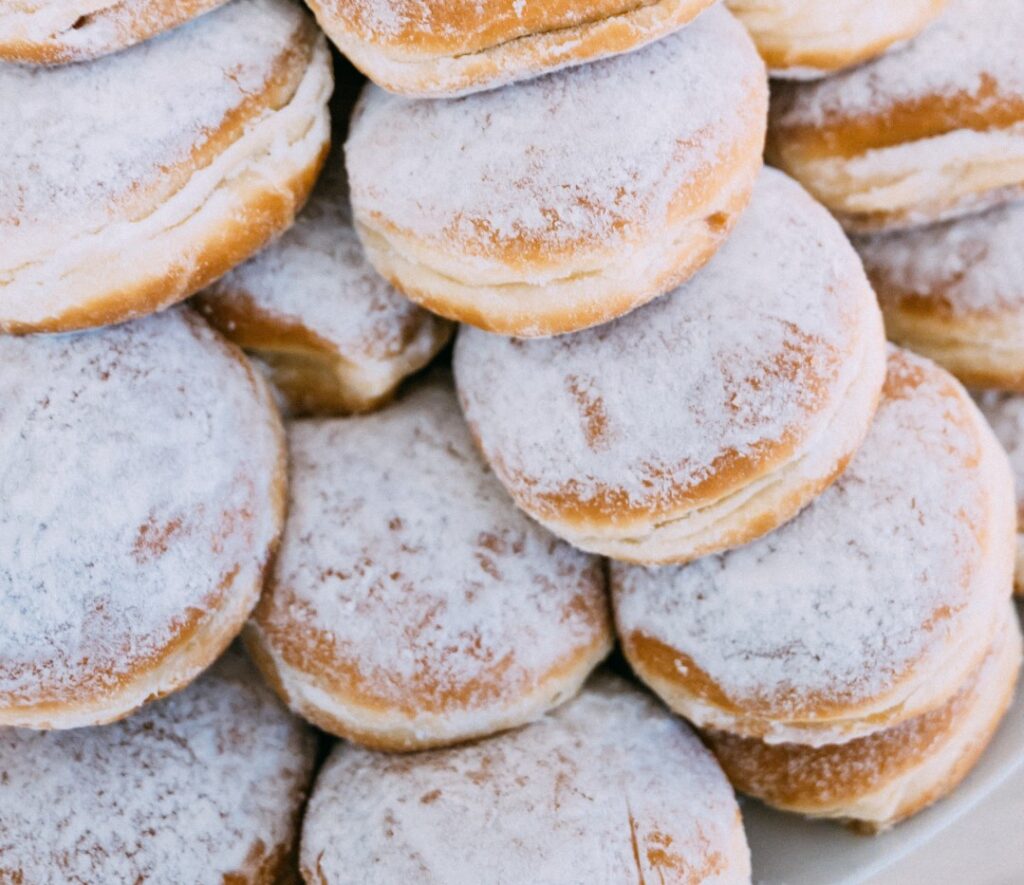
Frikadellen: The first time I had these “German Meatballs” was at a Christmas Market and when I asked the stall vendor what they were, she shrugged and said “Meat Cakes??” And that is basically what they are, but they are REALLY good! Depending on the region, they can just come as is in little meatball forms, in other places they are more of a patty style. Sometimes they are served with perfectly caramelized onions and on a bun as well!
Flönz: This blood sausage is eaten just about everywhere in the Rhineland during Karneval, but for it to get the title of “Flönz” it must be made following strict rules, including that it must be made in the Rheinland! It is such a beloved part of Karneval in this region that there are even songs dedicated to the wurst!
Halve Hahn: If you know a lick of German, you would be quick to guess that this food has something to do with a “Half Chicken” buuuut it actually has nothing to do with poultry! Instead, in the Rhineland region, if you get a “Halver Hahn” you’ll be handed a bread roll made of rye with cheese (traditionally, gouda), pickles, mustard, and butter. Often times there will also be onions and paprika. This is a very popular pub food as well in the area (perfect for sopping up that Kölsch beer!)
Potato Pancakes: Just about every region of Germany has it’s own name for “Potato Pancakes” from Reibekuchen to Rievkooche to Kartoffelpuffers but they are all pretty much the same- shredded pancakes fried to absolute perfection and served with either apple sauce or sour cream.
Pork Knuckle: Again, depending on the region and the dialogue, you might find this called something different, but here in Bavaria, it’s called a “Haxen” but near Cologne, you’ll see it called a “Hämcher.” It’s no surprise why this dish is associated with Karneval, as it is a pure, gluttonous delight of perfect, crackling skin, juicy fats, and tender meat! It’s one of my most recommended foods to try in Germany, regardless of the season, festivity, or location!
Tips for Karneval Germany
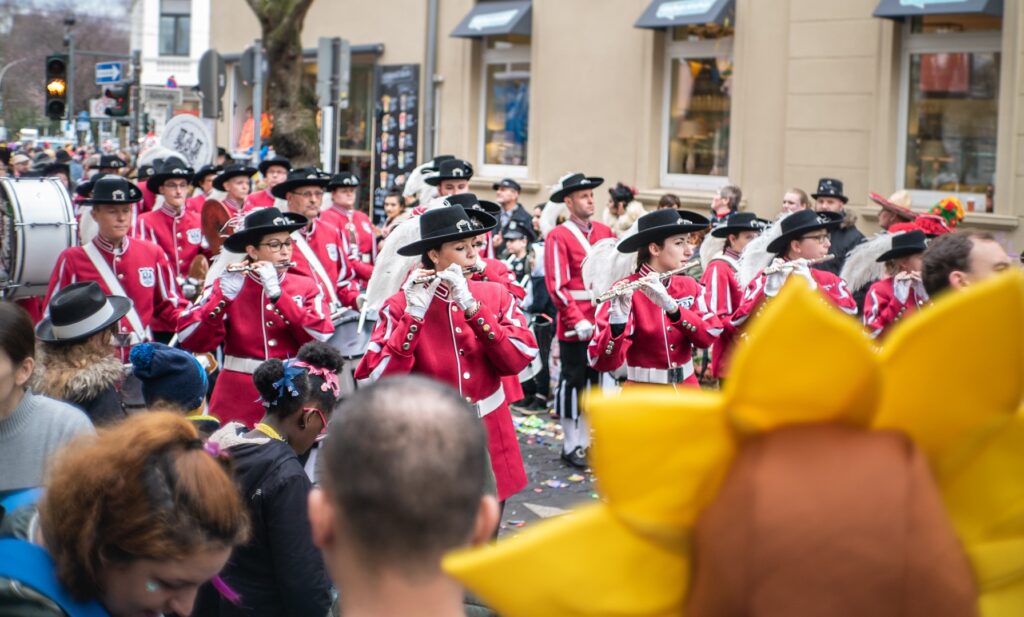
Prepare For Crowds
We’ll see how Karnevals and Faschings change with Covid, but traditionally, to say that it is crowded is still an understatement, especially if going to one of the larger festivals mentioned above. Whether you are at a pub or bar for an after-hours party or on the streets for a parade, don’t be surprised if you barely have any moving room.
Travel Light
A few drinks in and it’s easy to become forgetful. Try to go out for the day with as little as possible so that you don’t risk leaving things like purses and coats behind.
(If you are a tourist absolutely do not go out with your passport! Leave it at the hotel!)
Watch Your Pockets
Crowded places are the most popular areas to be a target of a quick and easy pick pocket scam. Be sure you have any valuables down deep into bags that can’t be grabbed easily and avoid keeping money in pockets that can be swiped without you even realizing it happened!
What To Wear and Bring
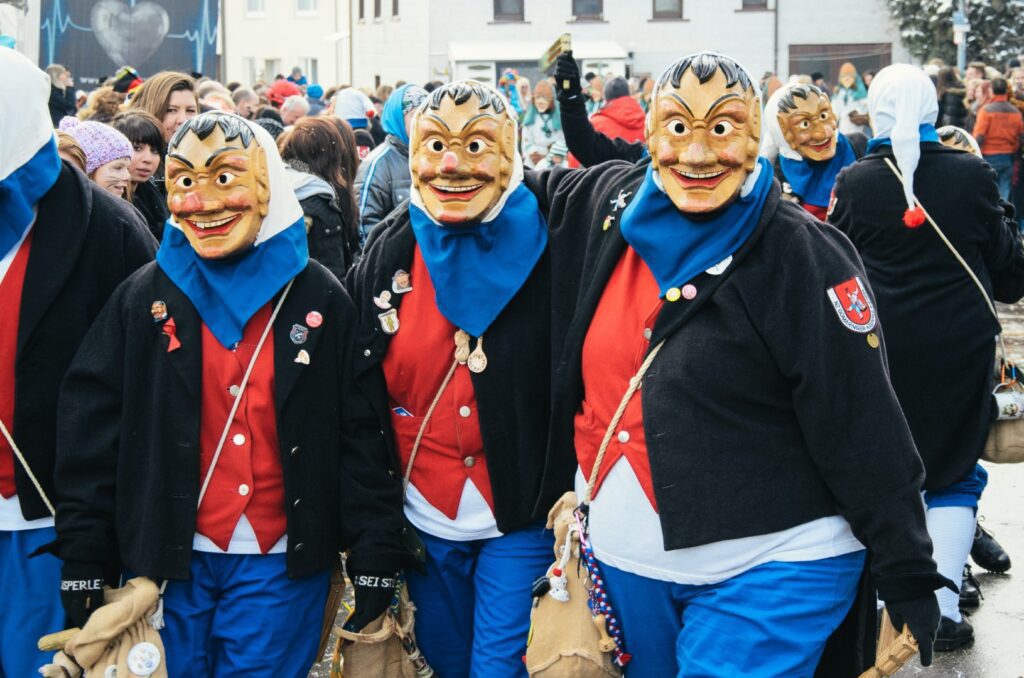
- Wear a Costume: If you don’t want to stand out, be sure to wear a costume! It can be absolutely ANYTHING from simple, homemade and put together last minute to elaborate, store bought, and crazy!
- Comfy Shoes: No matter how cute those heels would be with your costume, do NOT wear them! You’ll be on your feet ALL DAY, so comfort is key here folks! Better yet, OLD comfortable shoes. Why? Well, the smell of stale beer (or worse, vomit) isn’t always easy to get out of footwear!
- Waterproof Everything: It is notoriously rainy in February and March in Germany. Be sure to have waterproof everything!
– Waterproof Coat: If you don’t have a waterproof coat, be sure you have a poncho packed away that you can easily whip out if needed
– Waterproof Shoes: Yes, you’ll want them for all that potential rain, but you’ll also want them to repel all the beer that is bound to bounce onto your feet - A Foldable Bag: Pack a cloth or reusable bag because you’ll need something to stash all that candy in!
BYOB
No matter where you go, you’ll be able to purchase alcohol. But, if you are trying to travel to Germany on a budget, one way to save money is to simply stop at a Getränkemarkt before heading to a parade or festival in the town and getting a few beers for a fraction of the cost. Obviously, you can’t bring your own booze into places like bars, but for parties out on the street, it’s a great way to save and isn’t frowned upon at all!
Be Aware of Cultural Taboos
As a sweeping statement, Germans as a whole aren’t, how do I say this….well, aren’t as sensitive to cultural appropriation as Americans are becoming. Therefore, you need to prepare yourself for costumes that you will most likely deem extremely racist or are at least very, very misrepresented.
Learn A Few Basic Greetings for Karneval
One of the fun things about Karneval is all the local dialects that really come out. Depending on where you are, you’ll hear plenty of traditional greetings for Karneval, so make sure you know which one is correct for where you are visiting!
Cologne: “Alaaf”
Düsseldorf: “Halau”
Saarland: “Alleh hopp”
Swabia: “Narri-Narro”
Northern Coastal Towns: “Ahoi!”
Learn How To Stippeföttche
If you are in the Rhineland and really want to look like a local, learn the odd and hilarious Stippeföttche dance.
If you are looking for fun, unique, and cultural events to take part in while visiting Germany, Karneval and Fasching is an absolutely perfect way to get in with the locals and see a completely different side to Germany!
FAQS
When is Fasching in Germany 2023?
February 16th- February 21st
What is the Fasching Definition?
Typically celebrated in Bavaria Fasching is the festive season leading up to Lent. (Also known as Karneval, Carnival, or Fastnacht in other parts of Germany)
What Do You Wear to Fasching or Karneval?
Honestly, whatever costume you want! You can be a bear, a witch, or Super Mario for all anyone cares! Think of it kind of as America’s Halloween.
Why Do People Celebrate Karneval?
In the Catholic religion, Lent is a time of sacrificing, fasting, and repentance. Karneval is often seen as the “last chance” to really let loose, party, and to eat and drink everything your heart desires before having to spend the next several weeks giving up such “gluttonous” behaviors.
Is Fasching the Same as Karneval?
More or less, yes. The word “Karneval” is used more in the Rhineland region where Fasching is more commonly used in Bavaria.





